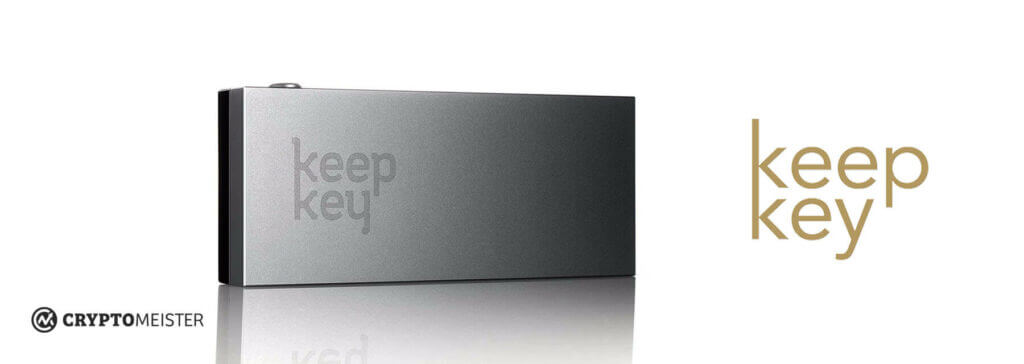KeepKey Wallet review
If the collapse of crypto exchanges in 2022 has taught us one thing, it’s that it is more important than ever to look after your own funds. When it comes to the best way of doing this, hardware wallets are the safest option by far.
One of the longest established players in the hardware market is Swiss exchange ShapeShift and its KeepKey hardware wallet. KeepKey was launched all the way back in 2015, a year before the Ledger Nano S made its debut. This made it the second hardware wallet on the market after the Trezor One, but it is still trusted by many, despite its age.
The question is, is the KeepKey hardware wallet still as reliable and functional today as it was back then? Let’s find out with our KeepKey review.
What is a KeepKey hardware wallet?

The KeepKey hardware wallet is a way to store multiple cryptocurrencies offline for extra security, safe in the knowledge that your funds can’t be taken without physical access to the device. The KeepKey itself is a USB-connected device with a metallic construction and large screen that has a more premium appearance compared to more recent devices, such as the plastic SafePal S1.
The KeepKey wallet is one of the larger devices you can buy, measuring around 3.5 x 1.5 inches and being half an inch thick. This certainly isn’t a device you’ll be carrying on your person, but then that’s probably a good thing. Despite its age its looks still hold up well, while the large screen means users can see long addresses in their entirety without having to scroll
The KeepKey only has one button which is used to confirm transactions.
The device also comes with a standard USB-USB Micro cable, meaning you can add another one to your undoubtedly growing collection.
How does a KeepKey wallet work?
The premise behind the KeepKey wallet, like all hardware wallets, is to ensure that only you have access to the funds held within it.
In truth, hardware wallets like KeepKey act as keys to a wallet, rather than as a wallet itself. To understand the difference, think of a blockchain (e.g. Ethereum) as a railway and your ETH coins as a train you own. Your train shares the same tracks as all the other trains, all of which must stay on the rail network at all times.
Seeing as you can’t take your train off the tracks, you need to store it somewhere safe, such as in a private depot. This depot is your Ethereum wallet, and the key to the depot is your hardware device – without that key, no one can drive your train away.
Hardware wallets achieve this level of security because they are rarely connected to the internet, meaning there is almost zero chance of your funds being hacked.
When you want to interact with your wallet, for example to send funds or add a new cryptocurrency, you will need to connect it to the KeepKey dApp through the ShapeShift website. All activities are carried out through the app, so it is vitally important that you ensure you are connected to the genuine KeepKey website and not an imposter site, or you could lose your funds.
This requirement to use a website compared to a self-contained application, as is the case with Trezor, Ledger, and SafePal, is something of a security worry, as the chance of an exploit is higher with an internet browser than with a dedicated app.
Every activity is conducted through the KeepKey dApp, with the device itself only used to confirm your intentions. When you want to send some coins, the instruction is sent from the dApp to the KeepKey, which will show the address you want to send to and the amount to be sent on the screen.
Once you’ve checked these are correct, a double press of the button on the device will confirm the transaction, allowing your train to leave the depot and start its journey to its destination. This simple yet secure method is still used by the latest hardware wallets, meaning this aspect of the hardware wallet is not out of date.
Supported cryptocurrencies
The KeepKey hardware wallet natively supports just seven cryptocurrencies – Bitcoin, Bitcoin Cash, Bitcoin Gold, DASH, Dogecoin, Ethereum and Litecoin – although it does have support for 40+ ERC-20 tokens.
This is a far cry from the thousands of coins and multiple NFT blockchains supported by newer devices, and is where the KeepKey really shows its age. ShapeShift’s resistance in upgrading the firmware means that no non-ERC-20 coins launched after 2015 are supported, which makes it very out of date in this respect.
It should also be noted that NFTs are also not supported by KeepKey, which is another example of how it is rapidly becoming obsolete, and the wallet doesn’t support other features such as staking either
KeepKey – the lowdown
Price
The KeepKey retailed at $239 when it launched in 2015, but can now be bought for $49, putting it on par with the newer and SafePal S1. While the SafePal S1 is of plastic construction rather than KeepKey’s metallic design, the former can boast support for over 10,000 cryptocurrencies as well as NFTs and has mobile app connectivity. This makes it a more secure option as well as a more functional one.
Security
KeepKey stores the private key to your wallet on its air-gapped chip, completely offline from the internet and other devices. This private key is used to reload a wallet’s contents if it gets damaged or lost, but it can also be used to break into the wallet remotely if it gets into the wrong hands, a risk present with all hardware wallets.
This concern was magnified in 2019 when hardware wallet maker Ledger discovered a flaw in the KeepKey design that allowed an experienced hacker with physical access to the device to extract the recovery phrase in less than five minutes. This was followed by the revelation of another flaw in which the PIN could also be extracted.
ShapeShift fixed the PIN vulnerability, but the recovery phrase vulnerability appears to be completely unfixable, because it relates to how the devices are manufactured, although ShapeShift argued that such a breach was almost impossible in practical terms.
Nevertheless, they are still concerns that need bearing in mind.
Setup
Setting up a KeepKey hardware wallet is very easy, and you can find tutorial videos if the instructions provided in the box aren’t clear. Everything is done through the KeepKey dApp, and during setup you’ll be told your recovery phrase as well as being asked to choose a PIN for the device. You’ll use this PIN every time you want to access the wallet to confirm transactions for extra security.
Once you’re set up, you’ll be asked to add wallets for the coins you’ll be storing. One of the advantages to ShapeShift being the creator of the KeepKey hardware wallet is that the dApp has the ShapeShift exchange built in, so you can easily swap coins in the dApp and have them stored straight on the device.
However, it’s important to note that, unlike newer wallets, KeepKey cannot be used in conjunction with major DeFi wallets and platforms such as Uniswap, MetaMask and MyEtherWallet.
Competition
When KeepKey launched it only had one competitor, the Trezor One, and it represented an improvement in terms of aesthetics over its older rival. However, the Trezor One supported over 1,000 coins compared KeepKey’s seven at the time of launch, meaning the latter has behind the curve on that front right from the off.
It’s no surprise that in a space that moves as fast as crypto, a wallet launched in 2015 is struggling against newer competition. The SafePal S1 can be bought for the same price, while the brand new Ledger Nano S Plus is just $30 more expensive, and boasts features such as NFT support and staking as well as more advanced features and a dedicated app.
While competing devices may not have the large screen that the KeepKey boasts, in all other areas they win out handsomely.
The verdict
In many ways it is hardly a surprise that KeepKey has fallen down the pecking order when it comes to the best cryptocurrency hardware wallet. It was launched more than seven years ago, during which time tens of thousands of coins have come and gone, and the fact that all KeepKey has done in that time is add support for some 40 ERC-20 coins speaks volumes.
The fact is that with newer and better hardware wallets on the market available for almost the same price as the KeepKey hardware wallet, there is no reason for anyone to buy this shiny brick any more.
Even if you only ever intend to use a wallet for storing Bitcoin or Ethereum, for the same price as a KeepKey you can buy a hardware wallet that has more advanced security features and a self-contained app, as well as active development. This doesn’t even take into consideration the lack of forward-thinking options such as staking or NFT storage.
On its website, ShapeShift still calls the KeepKey “the next frontier of crypto security”. That may have been true in 2015, but as we have found in this KeepKey review, it certainly isn’t today.

